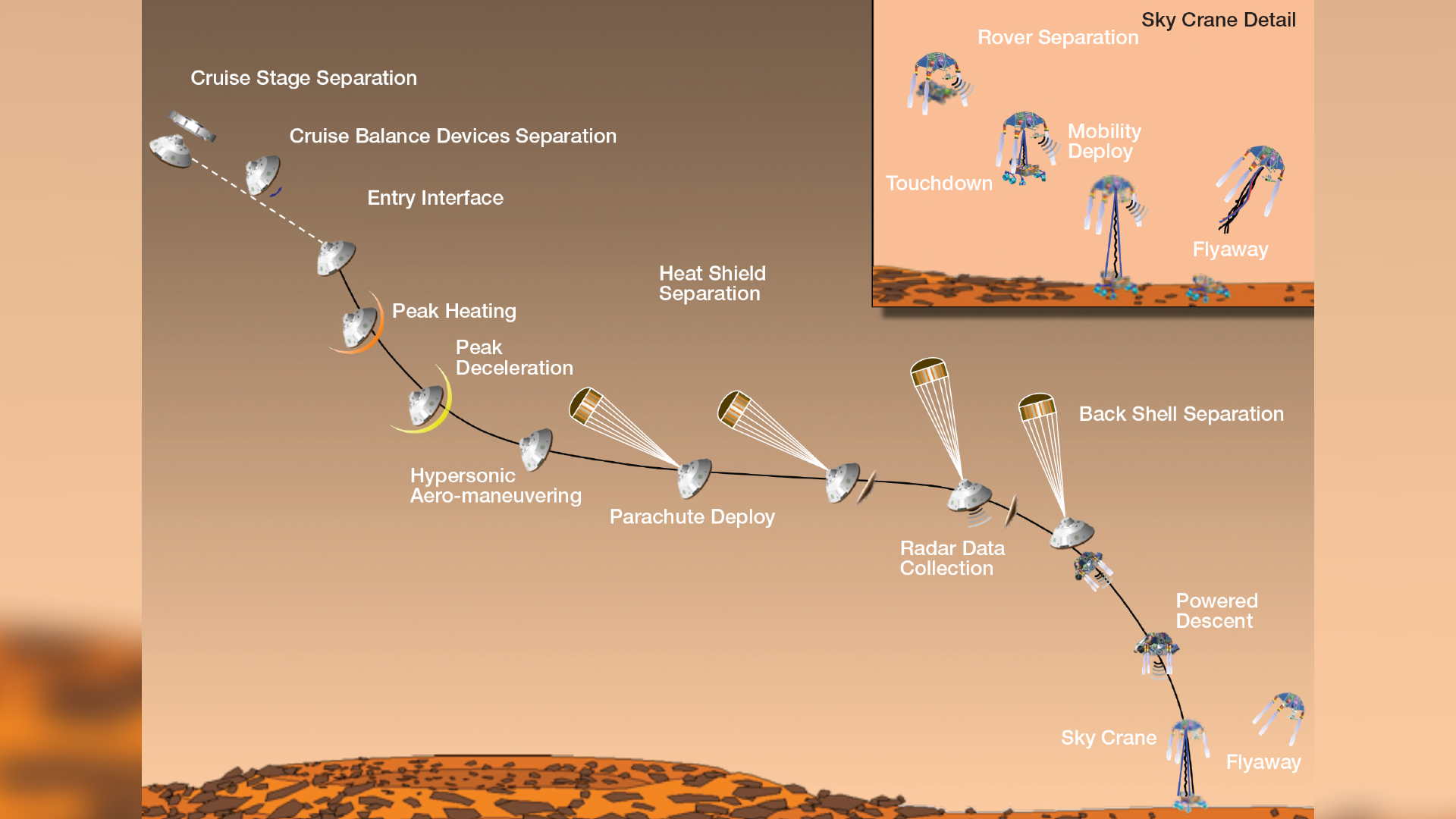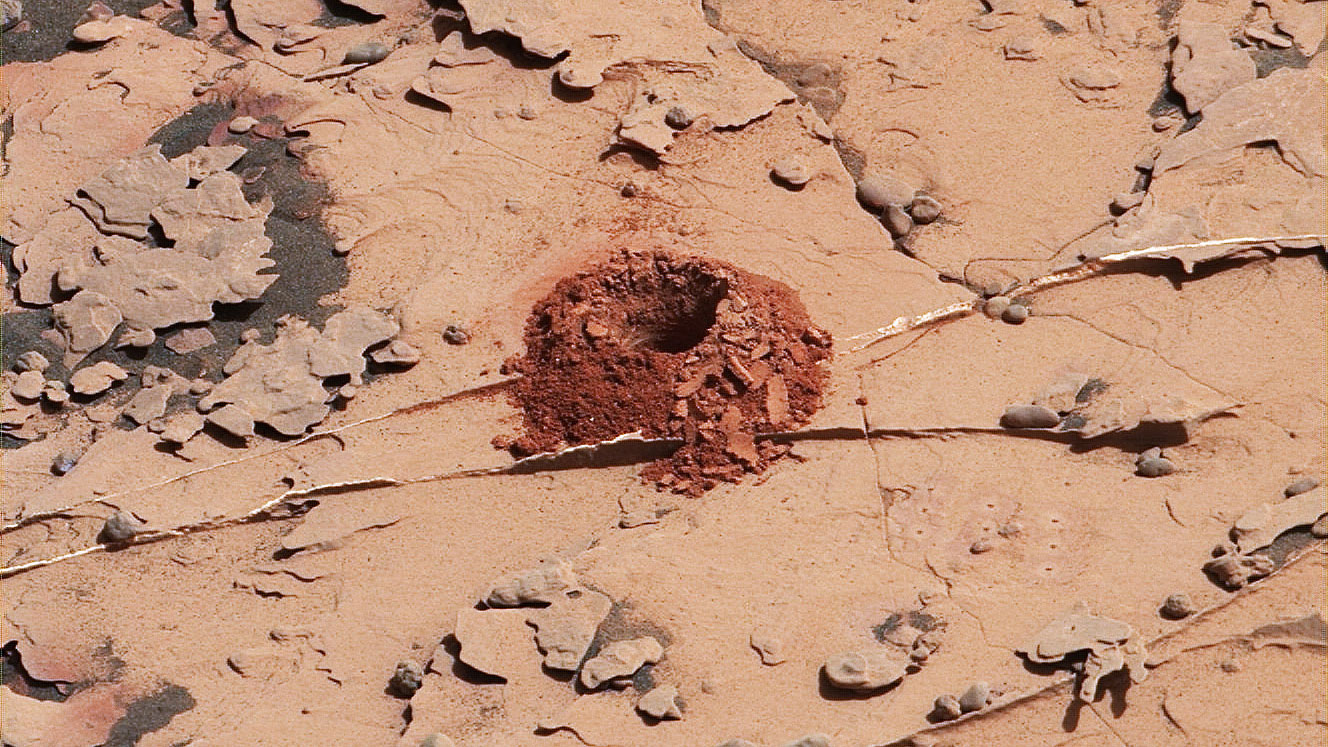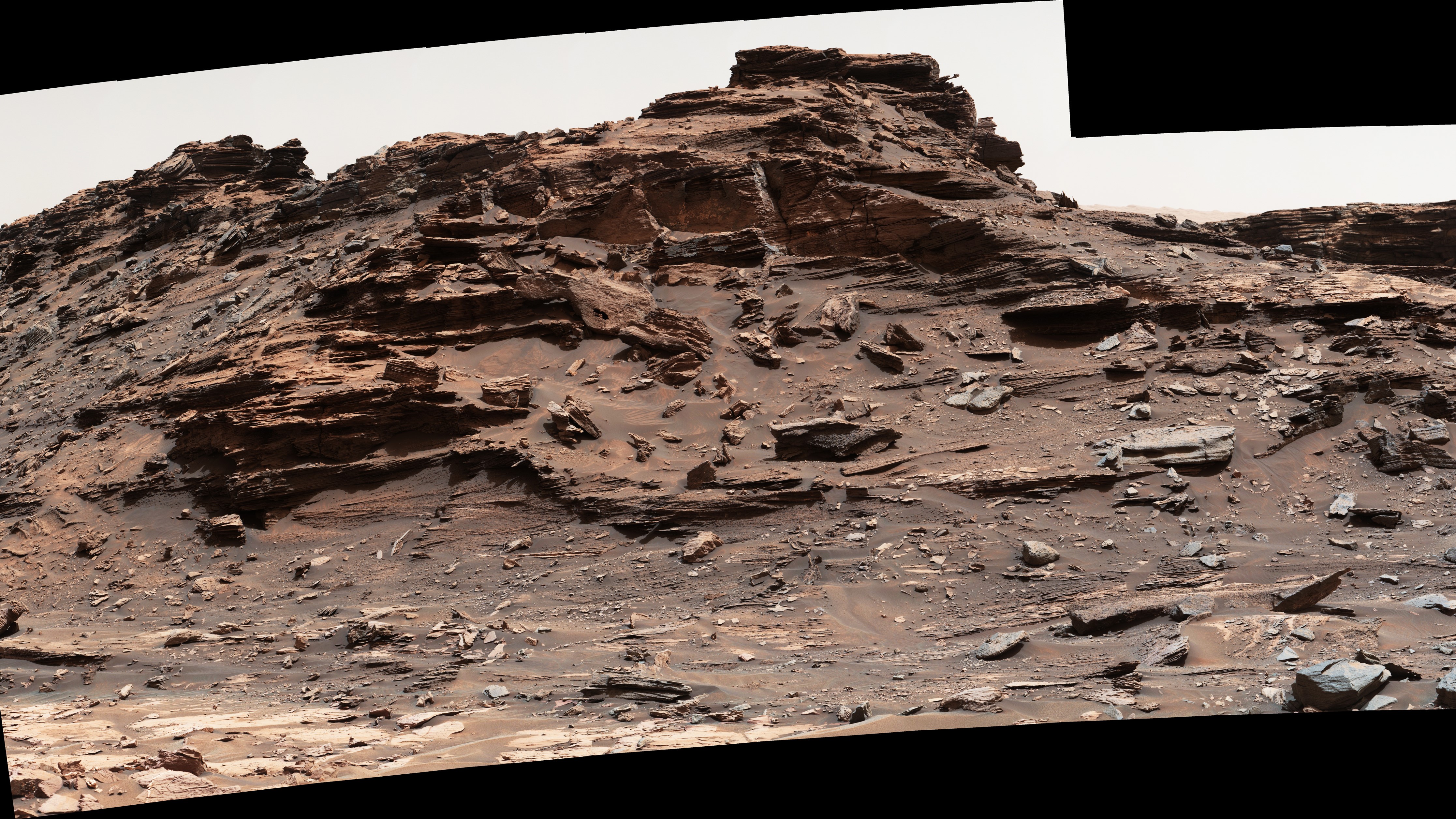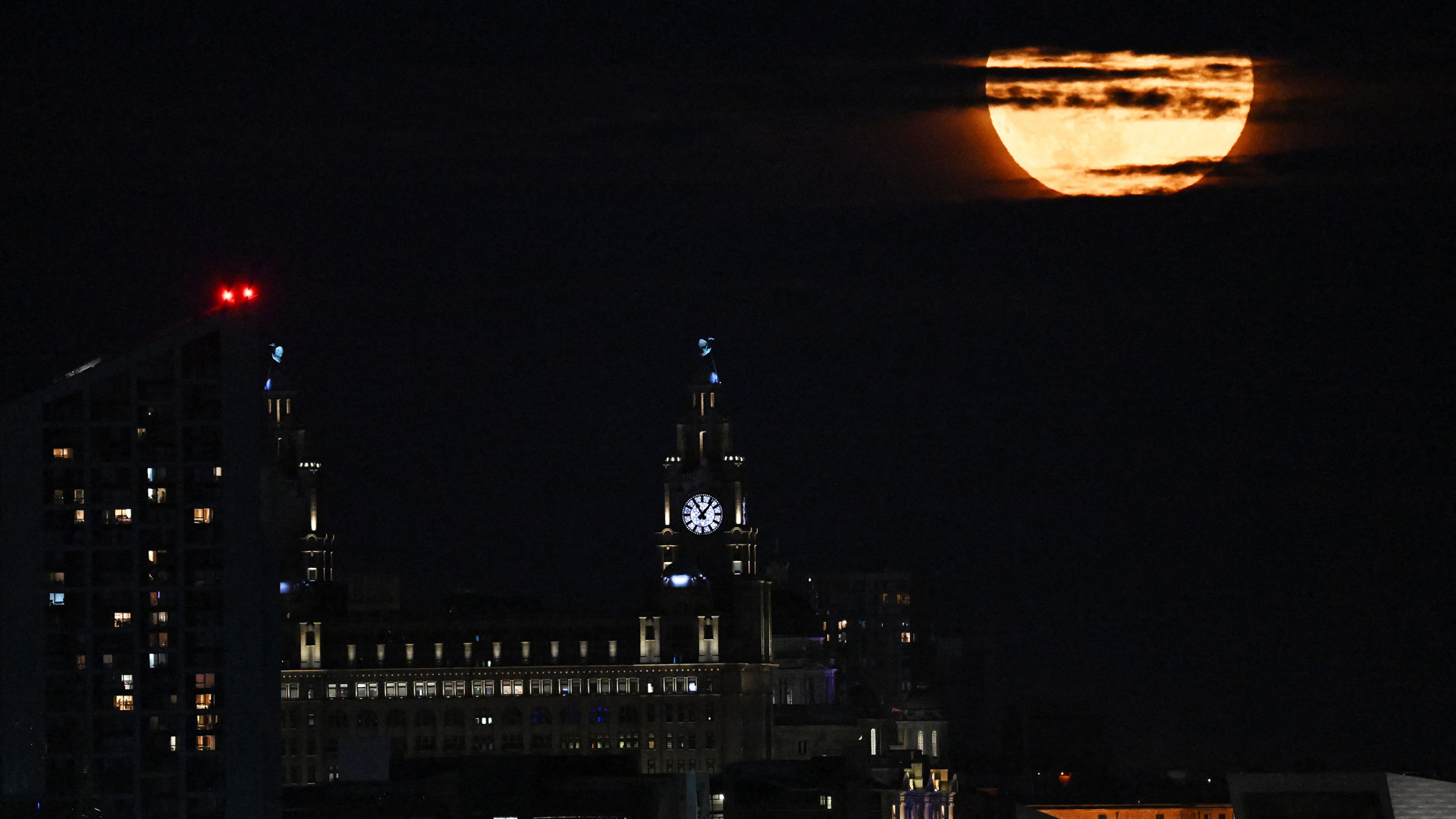Curiosity rover: The ultimate guide
For 10 years the robust rover has explored the Martian surface in great detail.
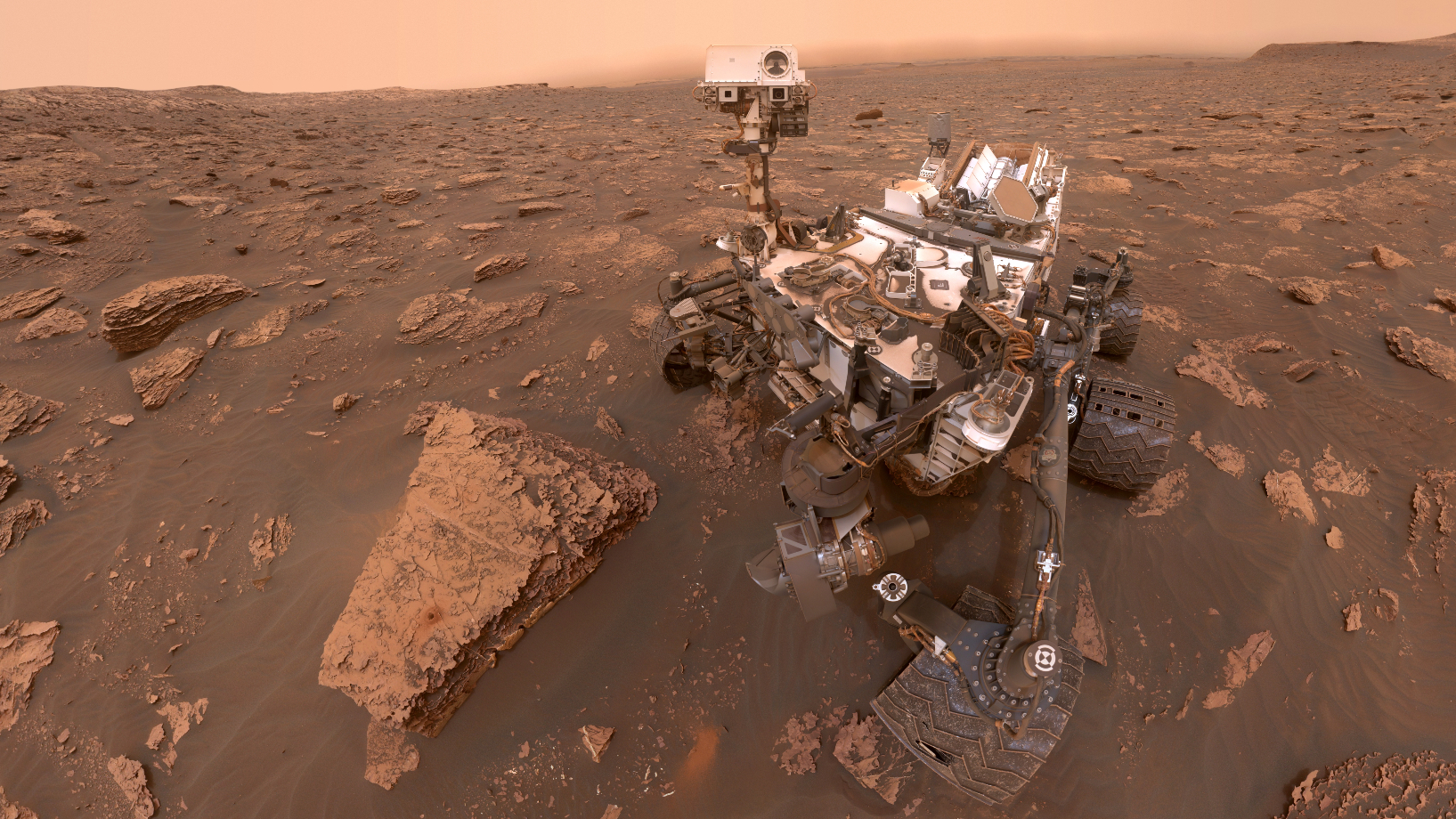
NASA's Curiosity rover is currently roaming Mars' landscape looking for signs of life and learning about the Red Planet's unique environment. As of Aug. 2, 2022, the rover has traveled 17.64 miles (28.39 kilometers).
Curiosity was launched aboard an Atlas V rocket from Cape Canaveral Air Force Station, Florida on Nov. 26, 2011, and landed on Aug. 5, 2012 after taking eight months and 10 days to reach the Red Planet.
The rover is part of NASA's Mars Science Laboratory mission which tested a novel landing method that saw the spacecraft descend on a parachute before its landing system fired up its rockets and hovered as the rover was lowered down onto the surface. A similar entry and landing process was repeated in Feb. 2021 when the Perseverance rover arrived on Mars.
Related: Celebrate 10 years of NASA's Curiosity rover with these incredible images (gallery)
During its decade exploring the Red Planet, Curiosity has journeyed from Gale Crater to Aeolis Mons (colloquially called Mount Sharp). During its travels, the rover has found extensive evidence of past water and geological change as well as shifts in climate.
For the latest news about the mission, follow Space.com's Curiosity Mars Rover coverage.
Curiosity: Size and speed
One thing that makes Curiosity stand out is its sheer size: Curiosity is about the size of a small SUV. It is 9 feet 10 inches long by 9 feet 1 inch wide (3 m by 2.8 m) and about 7 feet high (2.1 m). It weighs 2,000 lbs. (900 kilograms). Curiosity's wheels have a 20-inch (50.8 cm) diameter.
Breaking space news, the latest updates on rocket launches, skywatching events and more!
Engineers at NASA's Jet Propulsion Laboratory designed the rover to roll over obstacles up to 25 inches (65 centimeters) high and to travel about 660 feet (200 m) per day. The rover's power comes from a multi-mission radioisotope thermoelectric generator, which produces electricity from the heat of plutonium-238's radioactive decay.
Curiosity rover science goals
According to NASA, Curiosity has four main science goals in support of the agency's Mars exploration program:
- Determine whether life ever arose on Mars.
- Characterize the climate of Mars.
- Characterize the geology of Mars.
- Prepare for human exploration.
The goals are closely interlinked. For example, understanding the current climate of Mars will also help determine whether humans can safely explore its surface. Studying the geology of Mars will help scientists better understand if the region near Curiosity's landing site was habitable. To assist with better meeting these large goals, NASA broke down the science goals into eight smaller objectives, ranging from biology to geology to planetary processes.
Curiosity's instruments
In support of the science, Curiosity has a suite of instruments on board to better examine the environment. This includes:
- Cameras that can take pictures of the landscape or of minerals close-up: Mast Camera (Mastcam), Mars Hand Lens Imager (MAHLI) and Mars Descent Imager (MARDI).
- Spectrometers to better characterize the composition of minerals on the Martian surface: Alpha Particle X-Ray Spectrometer (APXS), Chemistry & Camera (ChemCam), Chemistry & Mineralogy X-Ray Diffraction/X-Ray Fluorescence Instrument (CheMin), and Sample Analysis at Mars (SAM) Instrument Suite.
- Radiation detectors to get a sense of how much radiation bathes the surface, which helps scientists understand if humans can explore there – and if microbes could survive there. These are Radiation Assessment Detector (RAD) and Dynamic Albedo of Neutrons (DAN).
- Environmental sensors to look at the current weather. This is the Rover Environmental Monitoring Station (REMS).
- An atmospheric sensor called Mars Science Laboratory Entry Descent and Landing Instrument (MEDLI) was primarily used during the landing.
A complicated landing
The spacecraft arrived on Mars on Aug. 6, 2012, after a daring landing sequence that NASA dubbed "Seven Minutes of Terror." Because of Curiosity's weight, NASA determined that the past method of using a rolling method with land bags would probably not work. Instead, the rover went through an extremely complicated sequence of maneuvers to land.
From a fiery entry into the atmosphere, a supersonic parachute needed to deploy to slow the spacecraft. NASA officials said the parachute would need to withstand 65,000 lbs. (29,480 kg) to break the spacecraft's fall to the surface.
Under the parachute, MSL let go of the bottom of its heat shield so that it could get a radar fix on the surface and figure out its altitude. The parachute could only slow MSL to 200 mph (322 kph), far too fast for landing. To solve the problem, engineers designed the assembly to cut off the parachute, and use rockets for the final part of the landing sequence.
About 60 feet (18 m) above the surface, MSL's "sky crane" deployed. The landing assembly dangled the rover below the rockets using a 20-foot (6 m) tether. Falling at 1.5 mph (2.4 kph), MSL gently touched the ground in Gale Crater about the same moment the sky crane severed the link and flew away, crashing into the surface.
NASA personnel tensely watched the rover's descent on live television. When they received confirmation that Curiosity was safe, engineers pumped fists and jumped up and down in jubilation.
How is Curiosity looking for signs of life?
The rover has a few tools to search for habitability. Among them is an experiment that bombards the surface with neutrons, which would slow down if they encountered hydrogen atoms: one of the elements of water.
Curiosity's 7-foot arm can pick up samples from the surface and cook them inside the rover, sniffing the gases that come out of there and analyzing them for clues as to how the rocks and soil formed.
The Sample Analysis of Mars instrument, if it does pick up evidence of organic material, can double-check that. On Curiosity's front, under foil covers, are several ceramic blocks infused with artificial organic compounds.
Curiosity can drill into each of these blocks and place a sample into its oven to measure its composition. Researchers will then see if organics appear that were not supposed to be in the block. If so, scientists will likely determine these are organisms hitchhiking from Earth.
High-resolution cameras surrounding the rover take pictures as it moves, providing visual information that can be compared to environments on Earth. This was used when Curiosity found evidence of a streambed, for example.
In September 2014, Curiosity arrived at its science destination, Mount Sharp (Aeolis Mons) shortly after a NASA science review said the rover should do less driving and more searching for habitable destinations. It is now carefully evaluating the layers on the slope as it moves uphill. The goal is to see how the climate of Mars changed from a wet past to the drier, acidic conditions of today.
"I think the principal recommendation of the panel is that we drive less and drill more," Curiosity project scientist John Grotzinger said during a news conference at the time. "The recommendations of the review and what we want to do as a science team are going to align because we have now arrived at Mount Sharp."
Evidence for life: Organic molecules and methane
Curiosity's prime mission is to determine if Mars is, or was, suitable for life. While it is not designed to find life itself, the rover carries several instruments on board that can bring back information about the surrounding environment.
Scientists hit something close to the jackpot in early 2013 when the rover beamed back information showing that Mars had habitable conditions in the past.
Powder from the first drill samples that Curiosity obtained included the elements of sulfur, nitrogen, hydrogen, oxygen, phosphorus and carbon, which are all considered "building blocks" or fundamental elements that could support life. While this is not evidence of life itself, the find was still exciting to the scientists involved in the mission.
"A fundamental question for this mission is whether Mars could have supported a habitable environment," stated Michael Meyer, lead scientist for NASA's Mars Exploration Program. "From what we know now, the answer is yes."
Scientists also detected a huge spike in methane levels on Mars in late 2013 and early 2014, at a level of about 7 parts per billion (compared to the usual 0.3 ppb to 0.8 ppb). This was a notable finding because in some circumstances, methane is an indicator of microbial life. But it can also point to geological processes. In 2016, however, the team determined the methane spike was not a seasonal event. There are smaller background changes in methane, however, that could be linked to the seasons.
Curiosity also made the first definitive identification of organics on Mars, as announced in December 2014. Organics are considered life's building blocks, but do not necessarily point to the existence of life as they can also be created through chemical reactions.
"While the team can't conclude that there was life at Gale Crater, the discovery shows that the ancient environment offered a supply of reduced organic molecules for use as building blocks for life and an energy source for life," NASA stated at the time.
Initial results released at the Lunar and Planetary Science Conference in 2015 showed scientists found complex organic molecules in Martian samples stored inside the Curiosity rover but using an unexpected method. In 2018, results based on Curiosity's work added more evidence that life was possible on Mars. One study described the discovery of more organic molecules in 3.5-billion-year-old rocks, while the other showed that methane concentrations in the atmosphere change seasonally. (The seasonal changes could mean that the gas is produced from living organisms, but there's no definitive proof of that yet.)
In Jan. 2022, scientists announced that the rover had found some interesting organic compounds on the Red Planet. The compounds could be signs of ancient life on Mars but a lot more work is required to test that hypothesis.
What else is Curiosity looking for?
Besides hunting for habitability, Curiosity has other instruments on board that are designed to learn more about the environment surrounding it. Among those goals is to have a continuous record of weather and radiation observations to determine how suitable the site would be for an eventual human mission.
Curiosity's Radiation Assessment Detector runs for 15 minutes every hour to measure a swath of radiation on the ground and in the atmosphere. Scientists, in particular, are interested in measuring "secondary rays" or radiation that can generate lower-energy particles after it hits the gas molecules in the atmosphere. Gamma-rays or neutrons generated by this process can cause a risk to humans. Additionally, an ultraviolet sensor stuck on Curiosity's deck tracks radiation continuously.
In December 2013, NASA determined the radiation levels measured by Curiosity were manageable for a crewed Mars mission in the future. A mission with 180 days flying to Mars, 500 days on the surface and 180 days heading back to Earth would create a dose of 1.01 sieverts, Curiosity's Radiation Assessment Detector determined. The total lifetime limit for European Space Agency astronauts is 1 sievert, which is associated with a 5-percent increase in fatal cancer risk over a person's lifetime.
The Rover Environmental Monitoring Station measures the wind's speed and charts its direction, as well as determines the temperature and humidity in the surrounding air. By 2016, scientists were able to see long-term trends in atmospheric pressure and air humidity. Some of these changes occur when the winter carbon-dioxide polar caps melt in the spring, dumping huge amounts of moisture into the air.
In June 2017, NASA announced Curiosity had a new software upgrade that would allow it to pick targets by itself. The update, called Autonomous Exploration for Gathering Increased Science (AEGIS), represented the first time artificial intelligence was deployed on a faraway spacecraft.
In early 2018, Curiosity sent back pictures of crystals that could have formed from ancient lakes on Mars. There are multiple hypotheses for these features, but one possibility is they are formed after salts are concentrated in an evaporating water lake. (Some Internet rumors speculated the features were signs of burrowing life, but NASA quickly discounted that hypothesis based on their linear angles — a feature that is very similar to crystalline growth.)
Curiosity's trials and tribulations
Vapors from a "wet chemistry" experiment filled with a fluid called MTBSTFA (N-methyl-N-tert-butyldimethylsilyl-trifluoroacetamide) contaminated a gas-sniffing analysis instrument shortly after Curiosity landed. Since the scientists knew the collected samples were already reacting with the vapor, they eventually derived a way to seek and preserve the organics after extracting, collecting and analyzing the vapor.
Curiosity had a dangerous computer glitch just six months after landing that put the rover within only an hour of losing contact with Earth forever, NASA revealed in 2017. Another brief glitch in 2016 briefly stopped science work, but the rover quickly resumed its mission.
In the months after landing, NASA noticed damage to the rover's wheels appearing much faster than expected. By 2014, controllers made in the rover's routing to slow down the appearance of dings and holes. "They are taking damage. That's the surprise we got back at the end of last year," said Jim Erickson, Curiosity project manager at NASA's Jet Propulsion Laboratory (JPL) in Pasadena, California, in a July 2014 interview. "We always expected we would get some holes in the wheels as we drove. It's just the magnitude of what we're seeing that was the surprise."
NASA pioneered a new drilling technique at Mount Sharp in February 2015 to begin operations at a lower setting, a requirement for working with the soft rock in some of the region. (Previously, a rock sample shattered after being probed with the drill.)
Engineers had mechanical trouble with Curiosity's drill starting in ate 2016, when a motor linked with two stabilizing posts on the drill bit ceased working. NASA examined several alternative drilling techniques, and on May 20, 2018, the drill obtained its first samples in more than 18 months. In 2020, Curiosity bounced back from yet another glitch when it lost its orientation partway through its last set of activities.
The rover's resilience is a testament to its robust design and the hardworking nature of the scientists involved in the mission. Because of this, the rover has rolled on past its two-Earth-year primary mission and continues to survey the planet 10 years after it landed.
Additional information
For up-to-date information on Curiosity's current location as well as seeing where it has been, check out NASA's where is the rover feature. This interactive tool from NASA lets you explore the surface of Mars with Curiosity and find out more about where the rover has been. Explore Curiosity in even more detail with this 3D rover feature.
Bibliography
NASA. Goals. NASA. Retrieved August 2, 2022, from https://mars.nasa.gov/msl/mission/science/goals/
NASA. Objectives. NASA. Retrieved August 2, 2022, from https://mars.nasa.gov/msl/mission/science/objectives/
NASA. Summary. NASA. Retrieved August 2, 2022, from https://mars.nasa.gov/msl/spacecraft/instruments/summary/
NASA. Where is curiosity? Location Map. NASA. Retrieved August 2, 2022, from https://mars.nasa.gov/msl/mission/where-is-the-rover/

Elizabeth Howell (she/her), Ph.D., was a staff writer in the spaceflight channel between 2022 and 2024 specializing in Canadian space news. She was contributing writer for Space.com for 10 years from 2012 to 2024. Elizabeth's reporting includes multiple exclusives with the White House, leading world coverage about a lost-and-found space tomato on the International Space Station, witnessing five human spaceflight launches on two continents, flying parabolic, working inside a spacesuit, and participating in a simulated Mars mission. Her latest book, "Why Am I Taller?" (ECW Press, 2022) is co-written with astronaut Dave Williams.
